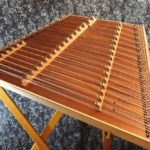Author Archives for friendlyadmin
 July 21, 2021 9:53 am
Published by friendlyadmin
July 21, 2021 9:53 am
Published by friendlyadmin
By Nicolette Foss Tuning by ear comes only with years of experience (*ahem* Chris), or through the rare inherent ability of those freaks-of-nature with perfect pitch. And we say to those freaks, hey this article is not for you! For the rest of us who get by with a little help from our device friends, stay tuned, this article is for you. But is a tuning app right for your tuning needs? In this article, we will discuss the advantages... Read More →
 May 11, 2020 1:39 pm
Published by friendlyadmin
May 11, 2020 1:39 pm
Published by friendlyadmin
Wood is constantly in motion. The technical term is hygroscopic, meaning it will absorb or release water based on the relative humidity at the time. As it absorbs or releases the water it shrinks or swells across the grain but not along the grain. This means your dulcimer can be affected by the amount of water in the air, causing its construction to shift and thus change the sound of your instrument. The amount of change can be quite a... Read More →
January 15, 2019 9:37 am
Published by friendlyadmin
Here is the why and how of the tongue and groove tops for the new Finch model hammered dulcimers. These are 2 photos of the tops before being glued to the frame, and you can easily see the tongue and groove joints. Here is why we need to build them this way. I built special humidity box to test a dulcimer we had built in the fall and kept it at 70-80% humidity for a couple weeks. It did... Read More →
August 7, 2017 9:51 am
Published by friendlyadmin
Wood is hygroscopic meaning it wants to absorb or release moisture based on the humidity of the environment. Wood reaches an equilibrium moisture content based on whatever the conditions are. In a humid Iowa summer any wood can get close to 12% moisture content (MC) in a non air conditioned home. In winter the same wood will pretty quickly drop to close to 6% MC in a normally heated home. When wood absorbs or loses moisture it shrinks or swells... Read More →
October 18, 2015 9:54 am
Published by friendlyadmin
I really like Minwax Wipe On Poly. I have been using it for years now as a sealer under shellac, but have recently discovered how to do a really nice hand rubbed finish with it. The secret is in the sanding. The finer the grit the surface is sanded to, the less poly it will absorb, and the quicker a gloss will develop. So I currently sand starting at 100#, then 150# over the whole dulcimer. The edges are sanded... Read More →
April 5, 2014 9:57 am
Published by friendlyadmin
There are many different performance situations where you would want to amplify your hammered dulcimer. If you are doing more than just jamming with friends, playing at home, or playing for more than a few people, then sound reinforcement is almost necessary. There are several ways to do it. Cheapest and easiest is to just point a standard dynamic mic like a Shure SM 57 or SM 58 at the dulcimer from above, and hook it to whatever sound system... Read More →
May 23, 2013 9:58 am
Published by friendlyadmin
At upwards of $12.00 per board foot for the good stuff, Walnut has gotten too expensive. We used walnut for all our bridges and the rails of the Phoebe hammered dulcimers for 20 years. Wood prices run in a cycle based on whether dark woods are in style, or light woods. For the last 20 years, light furniture, light kitchens, pickled woods, white on white were the vogue, so walnut was affordable. But now the trend has reversed. So we... Read More →
March 4, 2013 10:00 am
Published by friendlyadmin
I have to thank the guys at Woodsmith on PBS for this great technique. It needs to be shared with the world. Since shellac is a universal sealer, and will stick to anything, you can put it right on over wet oil, and it will seal the oil in. Pretty amazing. Hand rubbed oil finishes are the deepest and most beautiful, but take a lot of time. But with shellac in the mix, you can do a complete finish in... Read More →
December 23, 2012 10:02 am
Published by friendlyadmin
I have been spraying shellac in production finishing of our hammered dulcimers for a year now, and have come up with a few more tricks, so thought I’d update. Read the former post on the same topic, this is additional material to that. I have found that shellac sprays best if it is mixed at an EXACT one pound cut. This is pretty easy to do. I have a jar that I dissolve the flakes in that is something less... Read More →
May 2, 2012 10:04 am
Published by friendlyadmin
It was impossible to find any info on this on the net, and since I have been working on it very hard for several months, and have it figured out, thought I’d post my experience. I have been spraying lacquer on the hammered dulcimers that we build now for over 20 years. Figure I have finished at least 5,000 of them myself, so am pretty good with a spray gun. But lacquer is toxic, and even though I protect myself... Read More →
January 14, 2012 10:07 am
Published by friendlyadmin
I have been spraying lacquer for twenty years now. Hated it the whole time. It is nasty stuff. I have to wear a complete hazmat suit, respirator, rubber gloves, boots, and still I can’t help getting a small dose. It is also bad for the environment. I can’t see how I am being a good steward of the Earth by spraying these chemicals out into the air. But it is fast, and looks good. I have been looking for an... Read More →
June 3, 2011 10:09 am
Published by friendlyadmin
For many years we built the Whippoorwill and Warbler dulcimers with solid Honduras Mahogany tops. We were buying it from some folks in St. Louis that imported it directly. Otherwise known as “Genuine” Mahogany, it was a truly great tone wood. But in the very late 1990s an international ban was put in place on trade of Honduras Mahogany taken from its native range. By 2007 the supply of it had dwindled to the point that it became unavailable for... Read More →


